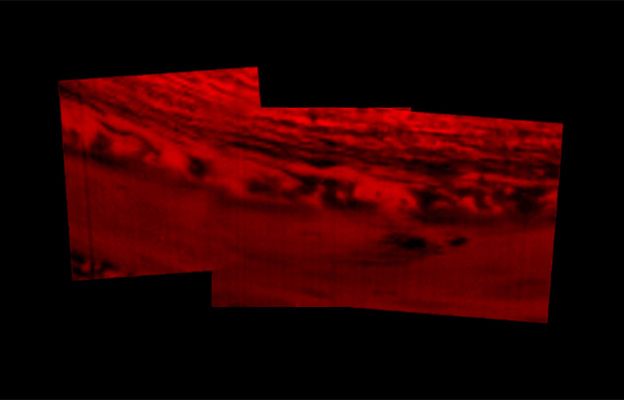It survived for about a minute before being broken apart.
Cassini had run out of fuel and Nasa had determined that the probe should not be allowed to simply wander uncontrolled among Saturn and its moons.
The loss of signal from the spacecraft occurred right on cue. Here at mission control, at the Jet Propulsion Laboratory in Pasadena, California, this drop-off was timed at 05:55 PDT (11:55 GMT; 12:55 BST).
How the last hours unfolded
Nasa's Earl Maize addressed fellow controllers: "Congratulations to you all. This has been an incredible mission, an incredible spacecraft and you're all an incredible team. I'm going to call this end of mission. Project manager off the net."
The statement brought restrained applause and some comforting embraces.
The loss of signal indicated that the probe was tumbling wildly in the planet's gases. It could have survived the violence for no more than about 45 seconds before being torn to pieces.
Cassini: A mission of 'astonishing discovery'
Meet the people who made Cassini happen
In Pictures: Cassini probe's greatest shots
What were the mission's biggest findings?
And so ends one of the most successful space missions in history.
In its thirteen years at Saturn, Cassini has transformed our understanding of the sixth planet from the Sun.
It has watched monster storms encircle the globe; it witnessed the delicate interplay of ice particles move through the planet's complex ring system; and it revealed extraordinary new insights on the potential habitability of Saturn's moons.
Titan and Enceladus were the standout investigations.
The former is a bizarre place where liquid methane rains from an orange sky and runs into huge lakes. Cassini put a small European robot called Huygens on Titan's surface in 2005. It returned a remarkable image of pebbles that had been smoothed and rounded by the action of that flowing methane.
Cassini also spied what are presumed to be volcanoes that spew an icy slush and vast dunes made from a plastic-like sand.
On Enceladus, the observations were no less stunning.
This moon was seen to spurt water vapour into space from cracks at its south pole. The H20 came from an ocean held beneath the icy shell of Enceladus.
When Cassini flew through the water plumes, it showed that conditions in the sub-surface ocean were very probably suitable for life.
Today, scientists are already talking about how they can go back with another, more capable probe to investigate this idea further.
A great many of those researchers have been gathered this week at the nearby campus of the California Institute of Technology. They watched a feed from the control room at JPL on giant screens.
Jonathan Lunine, from Cornell University at Ithaca, New York, spoke for many when he said: "I feel sad but I've felt sad the whole week; we knew this was going happen. And Cassini performed exactly as she was supposed to and I bet there is some terrific data on the ground now about Saturn's atmosphere."
And Linda Spilker, the Nasa Cassini project scientist, added: "Cassini may be gone, but its scientific bounty will keep us occupied for many years.
"We've only scratched the surface of what we can learn from the mountain of data it has sent back over its lifetime."







No comments: